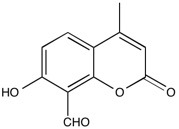4µ8C | IRE1 ribonuclease inhibitor
NMR (Conforms)

Available Options
| Size : | Price | Quantity | |
|---|---|---|---|
| 5 mg | $32.00 | ||
| 25 mg | $100.00 |
4μ8C (14003-96-4) is a selective inhibitor of IRE1α ribonuclease (RNase) activity (IC50 = 60 nM). Covalently binds to lysine 907 in the IRE1 endonuclease domain, blocking substrate access to the active site of IRE1α and inactivating both XBP1 splicing and IRE1α-mediated mRNA degradation but not IRE1 kinase activity.1 Inhibits IRE1α in response to hypoxia or other ER stress-inducing agents but has no effect on proliferation or clonogenic survival of hypoxic cells.2 Blocks production of IL-4, IL-5 and IL-13 production in T cells.3 4μ8C prevents the splicing of the XBP1 mRNA in response to ER stress caused by mutant proinsulin production in pancreatic β-cells.4
References/Citations:
1) Cross et al. (2012), The molecular basis for selective inhibition of unconventional mRNA splicing by an IRE1-binding small molecule; Proc. Natl. Acad. Sci. USA, 109 E869
2) Cojocari et al. (2013), New small molecule inhibitors of UPR activation demonstrate that PERK, but not IRE1α signaling is essential for promoting adaptation and survival to hypoxia; Radiother. Oncol., 108 541
3) Kemp et al. (2013), The serine-threonine kinase inositol-requiring enzyme 1α (IRE1α) promotes IL-4 production in T helper cells; J. Biol. Chem., 288 33272
4) Zhang et al. (2014), IRE1 inhibition perturbs the unfolded protein response in a pancreatic β-cell line expressing mutant proinsulin, but does not sensitize the cells to apoptosis; BMC Cell Biol., 15 29
NMR (Conforms)
Safety Data Sheet:
Product Data Sheet:
Materials provided by Focus Biomolecules are for laboratory research use only and are not intended for human or veterinary applications. Please note that we do not sell to individuals and that all orders placed by non-research organizations will incur a $20 restocking/refund fee
4μ8C (14003-96-4) is a selective inhibitor of IRE1α ribonuclease (RNase) activity (IC50 = 60 nM). Covalently binds to lysine 907 in the IRE1 endonuclease domain, blocking substrate access to the active site of IRE1α and inactivating both XBP1 splicing and IRE1α-mediated mRNA degradation but not IRE1 kinase activity.1 Inhibits IRE1α in response to hypoxia or other ER stress-inducing agents but has no effect on proliferation or clonogenic survival of hypoxic cells.2 Blocks production of IL-4, IL-5 and IL-13 production in T cells.3 4μ8C prevents the splicing of the XBP1 mRNA in response to ER stress caused by mutant proinsulin production in pancreatic β-cells.4
References/Citations:
1) Cross et al. (2012), The molecular basis for selective inhibition of unconventional mRNA splicing by an IRE1-binding small molecule; Proc. Natl. Acad. Sci. USA, 109 E869
2) Cojocari et al. (2013), New small molecule inhibitors of UPR activation demonstrate that PERK, but not IRE1α signaling is essential for promoting adaptation and survival to hypoxia; Radiother. Oncol., 108 541
3) Kemp et al. (2013), The serine-threonine kinase inositol-requiring enzyme 1α (IRE1α) promotes IL-4 production in T helper cells; J. Biol. Chem., 288 33272
4) Zhang et al. (2014), IRE1 inhibition perturbs the unfolded protein response in a pancreatic β-cell line expressing mutant proinsulin, but does not sensitize the cells to apoptosis; BMC Cell Biol., 15 29
Related ER Stress Products
Download
Calculate the molar concentration, mass or volume in a solution.
Concentration × Volume × Molecular Weight = Mass
Focus Biomolecules • Plymouth Meeting, PA USA • 1-855-FOCUS21
Focus Biomolecules
Plymouth Meeting, PA USA
1-855-FOCUS21
Website Created by Advanta Advertising LLC.

